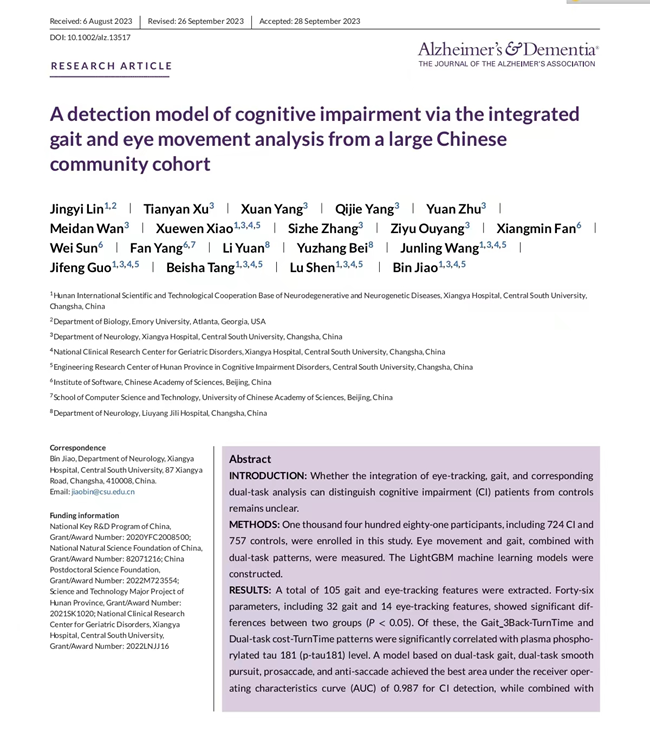On October 25, Professor Shen Lu and Associate Researcher Jiao Bin from the Department of Neurology at Xiangya Hospital of Central South University (CSU) and the National Clinical Research Center for Geriatric Disorders (Xiangya Hospital) published the latest research findings as an online paper titled “A detection model of cognitive impairment via the integrated gait and eye movement analysis from a large Chinese community cohort” in the top neurology journal Alzheimer & Dementia. This research found for the first time that the integrated gait and eye movement analysis under dual tasks can identify patients with cognitive impairment at an early stage, and is expected to provide a non-invasive, more objective and simple cognitive impairment screening method for the elderly. Lin Jingyi from Hunan International Scientific and Technological Innovation and Cooperation Base for Precise Diagnosis and Treatment of Neurodegenerative and Neurogenetic Diseases is the first author of the paper. Jiao Bin, associate researcher of the Department of Neurology of Xiangya Hospital, is the corresponding author. Professor Shen Lu is an important participating author. Professor Fan Xiangmin from the Institute of Software Chinese Academy of Sciences (CAS) is the partner author. CSU Xiangya Hospital is the affiliation of the first author and the corresponding author.

The prevalence of senile dementia is high. There are about 15 million dementia patients among the elderly aged 60 and above in China. Their health and life quality are greatly affected. Professor Shen Lu and Associate Researcher Jiao Bin's team recruited 1,481 elderly people aged over 60 in the community for the research. In addition to cognitive assessments, they also used EyeKnow and ReadyGo devices independently developed by the CAS team to collect eye-tracking and gait features of these elderly people. Eye movement parameters collected included smooth pursuit, prosaccade and anti-saccade; Gait parameters included stride length, stride speed, turning and arm swing speed. The research findings have shown significant differences in up to 32 gait and 14 eye-tracking features between the cognitive impairment group and the cognitive normal group. Of these, the Gait_3Back-TurnTime and DTC-TurnTime patterns were significantly correlated with plasma phospho-rylated tau 181 (p-tau181) level, suggesting that changes in these two indicators may be associated with Alzheimer’s disease (AD).
ROC analysis results have shown that the efficacies of gait parameters in detecting cognitive impairment under pure gait and gait under tasks are only 0.544 and 0.798 respectively; The efficacies of eye movement parameters in detecting cognitive impairment under pure eye movement and eye movement under tasks are higher at 0.926 and 0.931 respectively; The efficacy of eye movement and gait parameters in detecting cognitive impairment under dual tasks is as high as 0.987. This new method is non-invasive, objective, cost-effective and efficient, bringing new ideas for early detection of cognitive impairment. In addition, so far there are no effective biomarkers to distinguish mild cognitive impairment (MCI) from the early stage of senile dementia. Research findings have shown that the efficacy of eye movement and gait combined with p-tau181 under dual tasks in detecting MCI can reach up to 0.824.
The integrated eye movement and gait analysis under dual tasks can more accurately identify patients with cognitive impairment from the community cohort. This simple and objective method is expected to be used for cognitive impairment screening in large-scale elderly populations, and ultimately realize early diagnosis and treatment of senile dementia.
(First Reviewer: Zhang Xu, Second Reviewer: Wang Xuan, Third Reviewer: Li Yin)
Source: Xiangya Hospital
Original article link: https://news.csu.edu.cn/info/1003/157182.htm











